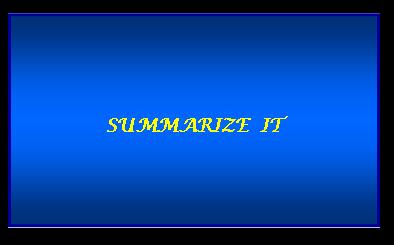How to Write an Effective Summary


By Joan Whetzel
There are two basic types of summary: the summary of a text that has been read and the summary of something that a person has written him- or herself. Writing an effective summary of someone else's work indicates a clear understanding of what was read. Writing a good summary of one's own work is a bit easier, because the person writing the summary is already familiar with the content of the essay or article. The trick is being able to write either type of summary quickly and making it different than the first paragraph or the essay or article.
What Is a Summary?
Summaries present a concise version of the article or essay that was read or written by the person creating the summary. Summaries should only be about two sentences to a paragraph in length, and should briefly describe the highlights and the theme of what was read or written, omitting the details.
It should not be an exact copy of the first paragraph of the essay or article. In the case of summarizing someone else's work, it would be considered plagiarism. In the case of summarizing one's own work it indicates that the writer couldn't be bothered with generating an original summary. If the summary is for an article or essay to be published online, be sure to use a few popular keywords (search terms).
Summary Types / Styles
A good summary should make the reader want to read further. Whether it's a summary of one's own work or a summary of another author's work, there are three basic styles of summary that can be used:
1. Informational Summary: This type of summary imparts an overview of the material in about 3 to 3 sentences. It should grab the readers' attention without giving the whole story away.
2. Analytical Summary: Writing this type of summary involves interpreting the information in the article or essay and stresses how the information was formulated and why it is important.
3. Provocative Summary: Provocative summaries should arouse the interest of readers in the topic of the article or essay. These summaries provide the summary writer's opinion and attitudes about the topic of the article or essay being summarized. To get the summary reader to wondering about the article or essay topic, provocative summaries make use of humor, sarcasm, iron, alliteration, and other literary devices.
Writing the Summary
Try these steps when writing a summary:
1. Divide the essay or article into sections.
2. Read the article or essay, highlighting the main ideas for each section.
3. Re-read the article or essay, jotting down the main ideas in your own words.
4. Go over the notes that you've jotted down for each section use them to write a thesis statement - a sentence the describes the theme or the entire article or essay.
5. Write a few sentences that briefly tells what the article or essay covers, without going into detail.
6. Write this summary in present tense, using your own words.
7. Re-read the summary to make sure it correctly covers the main ideas and key points of the article or summary and, if it quotes the text directly, that proper citations for the quote are in place. Also make sure the summary is a concise description of the article or essay.
8. Proofread and make any revisions for style, grammar and spelling.
Resources
e-Notes. How to Write a Summary in 8 Easy Steps.
http://www.enotes.com/topics/how-write-summary
Write Any Genre. How to Write a Summary.
http://www.writeanygenre.com/how-to-write-a-summary.html
Santa Rosa Junior College, Online Writing Lab. Writing Summaries.
http://srjcwritingcenter.com/summaries/summaries.html
JProf. Writing Summaries.
http://www.jprof.com/onlinejn/writingsummaries.html
Santa Monica College. Writing a Summary.
http://homepage.smc.edu/reading_lab/writing_a_summary.htm
Articles Base. Write Summaries that Get More Article Views.



